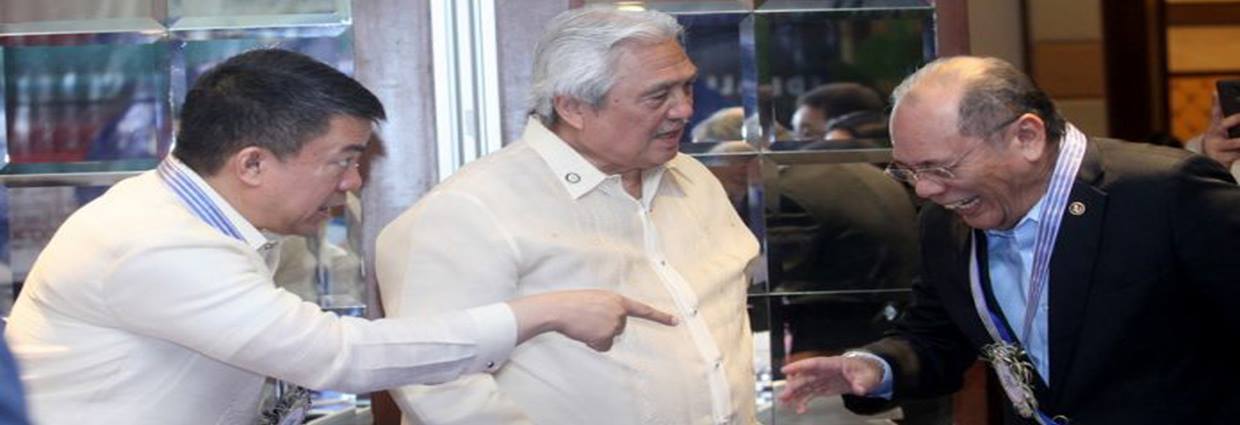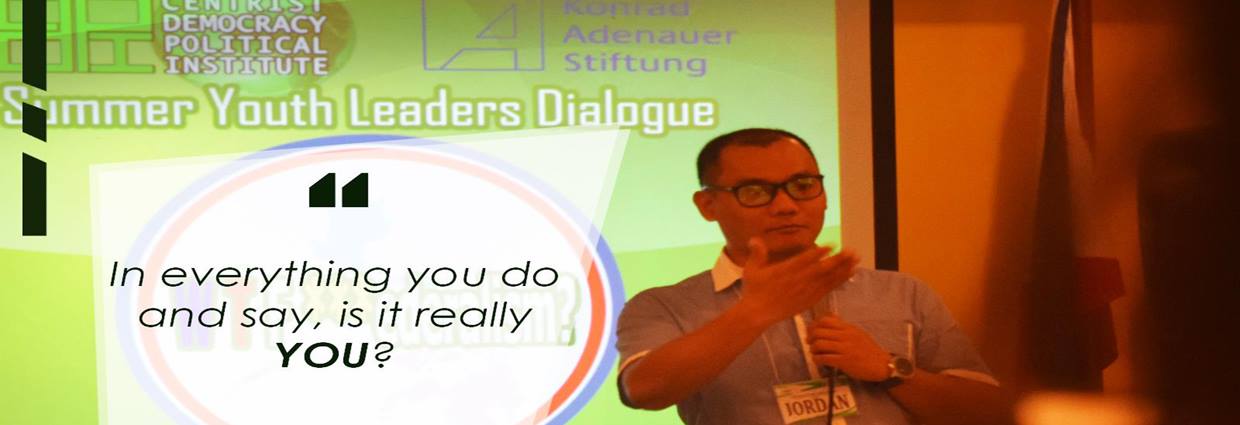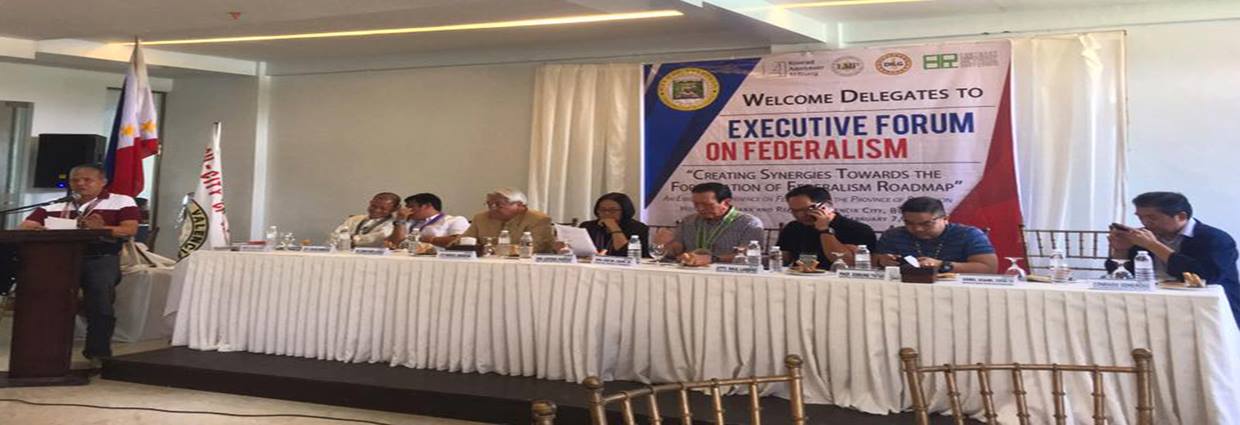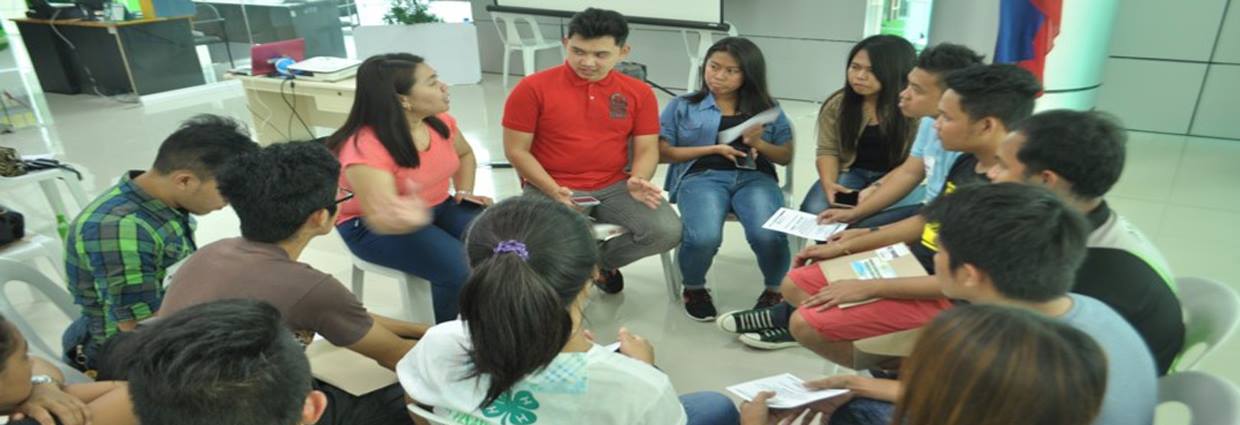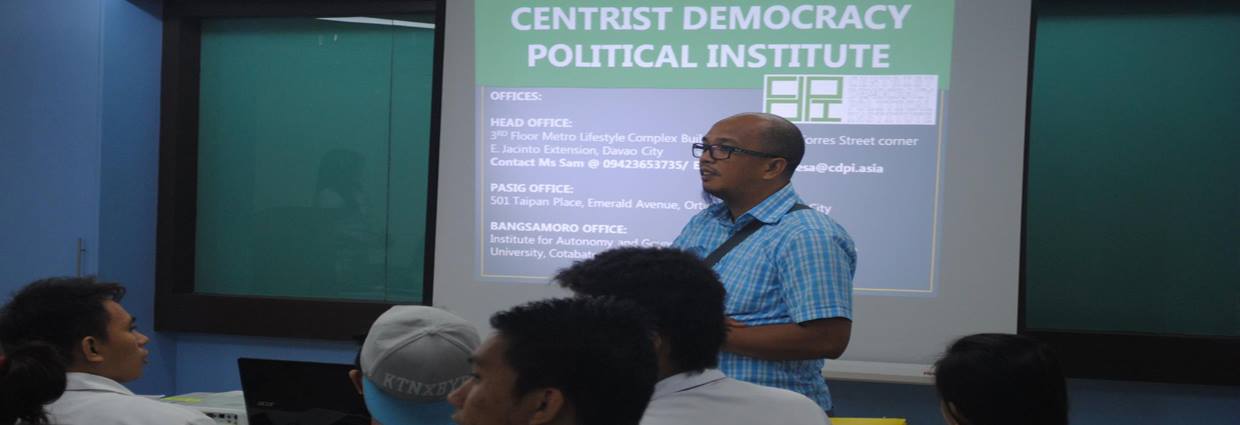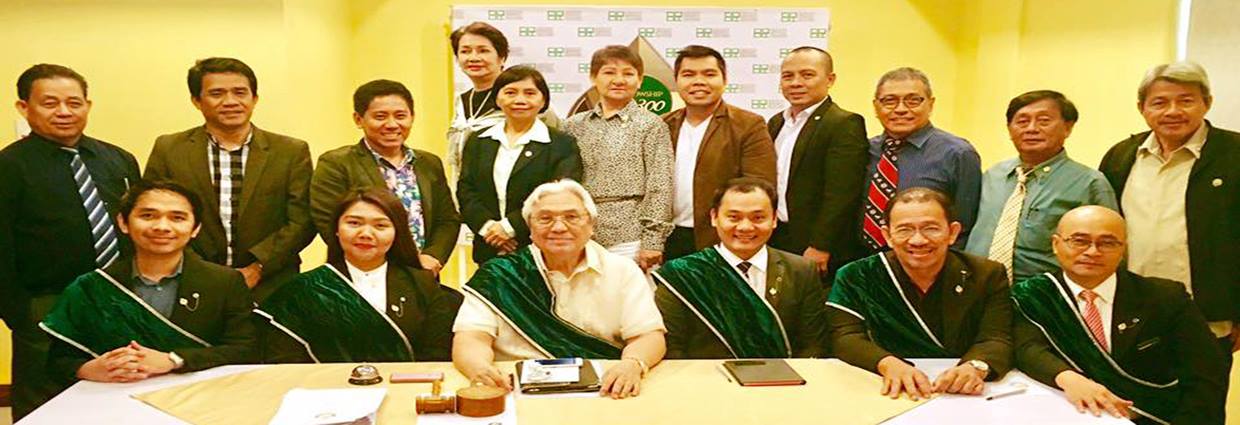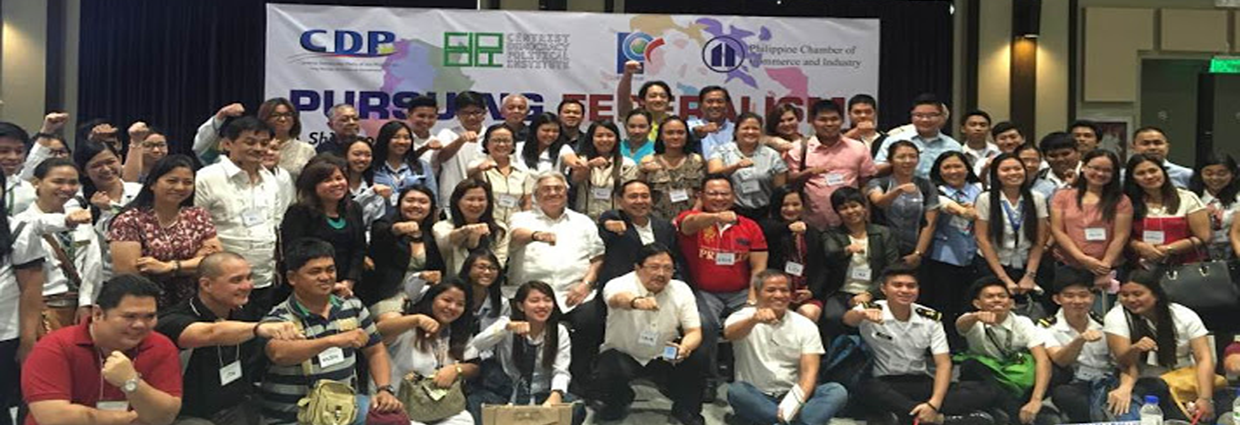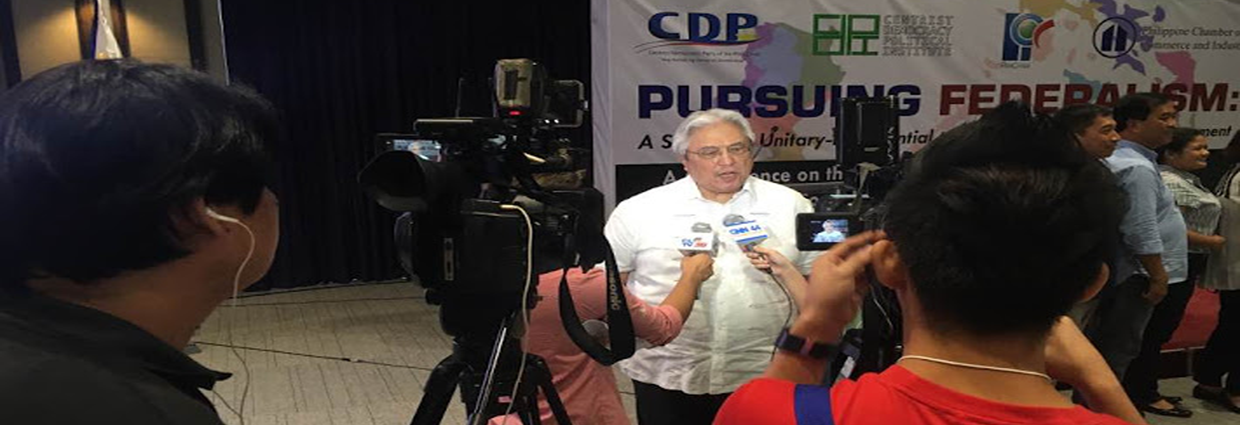Romualdez urges support for federalism to speed up growth
In a statement, Romualdez, a lawyer who is president of the Philippine Constitution Association (Philconsa), said federalism would complement the Duterte administration’s efforts to speed up economic growth.
“We will keep our dedication, commitment, passion and the flame burning in pursuing federalism until we reap the real benefits of genuine constitutional reforms for our children and the succeeding generations,” Romualdez, one of the frontrunners in the House speakership race, said.
“I urge my colleagues and the Filipino people to stand behind President Duterte and help push a federal Constitution to create opportunities and for strong economic growth to be felt also by ordinary people,” he added. “The federalism advocacy of President Duterte is a golden opportunity to unlock the doors of peace, progress and prosperity of the country and the people.”
Last December, the House of Representatives — voting 224-22, with three abstentions — approved on third and final reading its version of a federal constitution under Resolution of Both Houses No. 15, of which Speaker Gloria Macapagal-Arroyo is one of the principal authors.
Romualdez, the House independent bloc leader during the 16th Congress during the Aquino administration, also renewed Philconsa’s commitment to defend and protect the 1987 Constitution.
“Let us join hands to maintain the pristine supremacy of the Constitution,” said Romualdez, who will serve his fourth term as Leyte congressman in the incoming 18th Congress.
According to Romualdez, president of the Lakas-Christian Muslim Democrats (CMD), the 58-year-old Philconsa remains very supportive of the President’s federalism initiative.
“I am proud to say that the Philconsa has become the premier marketplace for the healthy and vibrant exchange of ideas, perceptions and insights on constitutional issues affecting public interest,” he said. “We have been doing this consistently with our aim to incite and stimulate awareness, respect and obedience to the Constitution.”
“The Philconsa is a classic paragon of democracy,” he added. “It encourages everyone to say his piece, and out of this composite of ideas, insights and impressions, we hope to reach a consensus on what is good and what is best for our country and our people.”
Aside from Romualdez, among the legal luminaries of Philconsa are retired Court of Appeals Justice Manuel “Lolong” Lazaro as chairman and former Chief Justice Reynato Puno as president emeritus.
Congress leadership fights as political porn
ON the heels of the recently concluded midterm elections another political circus has come to town. We are never given a respite. But looking from another’s point of view, it never ceases to entertain us. It is often said that in the Philippines, political circuses have been elevated to the equivalent of pornography. We watch disgusted, not as actors or participants, but in some way fascinated by the spectacle laid before us. And the mere act of watching fuels the supply. And we barely have a choice as the tri-media are drawn to it like moths to a lamp. And social media has of late been initiating the dissemination of these phenomena encompassing everyone with a device attached to the internet, including the masses, through the veritable but almost passé word of mouth.
This current political porn is played out by certain types of politicians not for sexual arousal but purely for personal excitement in pursuit of power. I refer to the porn stars now parading themselves to public scrutiny but directed mostly toward an audience of one — the President himself.
These are the winning politicians now gunning for the two most powerful positions after the presidency: Speaker of the House of Representatives (HoR) and President of the Senate. These two positions are the most prestigious and power-laden in the government hierarchy. Ranking only third in succession after the vice president who holds no power except only when the president is incapacitated or dead.
Congress has the power of the purse and technically controls the flow of monies — that in effect fuels the lifeblood of governance. The top honchos of each chamber therefore could have the handle on the levers of power — if we define political power as the ability to influence the course of events, their logical and desired outcomes and the behavior of the citizenry through the crafting of laws towards the overall health of the nation.
In our republican democratic system imposed on us through a century of American tutelage, Congress is one of the three branches of government, which, along with the judiciary and the presidency, provide the mechanism for checks and balances to maintain proper governance and the oneness of the nation.
Offhand, with the expressed and constitutionally protected powers of Congress, it could be perceived to be potentially more powerful than the presidency itself. The power to pass any law and appropriate any amount and the power to create any position in government; these are not within the powers of the presidency. Congress even has the power to remove a sitting president. But as advanced by Ross Cohen, an American history and political scientist, “… [the power of] Congress is fragmented. The President is not as powerful as the Congress in many respects, but his/her power is concentrated. It creates a unique balance of power that ensures no one person or institution ever becomes too powerful for too long, while still enabling a strong central government to react to the needs of the day without getting too far from the will of the people. This is the genius of the US Constitution”.
The Philippine experience is somewhat different from that of America’s almost 400 years of practice. The Philippine president has over the decades taken more powers from Congress and the unitary-presidential system has reinforced and centralized power in the presidency, all conveniently protected by the 1987 Constitution. In some ways congressional powers have been castrated although the positions of House speaker and Senate president are still residually very powerful. A caveat, however, is that they must be allied to the president and must have his support. The president’s web of alliances is extensive in both houses and the presidency’s tentacles reach out to the dynasties in the local government units (LGU). And it is the dynasty that gets a congressman enthroned.
More especially in the lower house, with its large numbers, the anointment of the president is a sine qua non for the speakership. Thus, the obsequious demeanor of the leading contenders towards the president and his very traditionally politicized family. We have the sorry display therefore of former speaker Bebot Alvarez who. despite a fresh electoral mandate after vanquishing his political foes allied to the president’s daughter, had to display mendicancy toward Sara, who in the first place was instrumental in his dethronement. Seeking a reconciliation, he was rebuffed. Now playing lamely to the first family, he declared that he was “giving up his ambition” if the president’s newly elected congressman son Polong desires the speakership.
We have Lord Velasco, a young but hard-nosed politician who went through two political parties, Lakas-Kampi-CMD and NUP but jumped to the winning PDP Laban and now parlaying a close relationship to the president’s family as his launching pad.
Reportedly leading the wannabees with 153 endorsement from his peers is the darling of the oligarchy and an old hand in Congress and scion of a political family, congressman-elect Martin Romualdez, of the Romualdez-Marcos clan. These last two contenders could sustain the contest with sufficient funds as the fight could become expensive, shamelessly buying congressional votes — as intimated by Alvarez. But in the end, it will be the Deegong’s imprimatur that counts.
It’s a little bit different at the Senate as there are only a few members, and therefore they must work out as a collegial body relying on negotiation and compromise. But the President’s nod is still a valuable asset what with the current set of new faces from the President’s coterie. The importance of the Senate is that it could be a stepping-stone to the presidency. So far in the storied history of both houses, only Ferdinand Marcos, Senate president in 1963-1965, made it to the presidency. None from the speakership (Ramon Mitra, Joe de Venecia and Manny Villar) who vied for the presidency.
So, the skeptics among us can deduce that aside from prestige and residual powers, in a corruptible unitary-presidential system, the speakership and senate presidency must be immensely lucrative. Thus, the frenetic kowtowing to the one true power that can grant them their wishes.
But the last three years of Deegong’s term call for him to be above himself, to be a statesman and be presidential. He must therefore choose the Congress leaders who could partner with him truly to advance his agenda — real systemic reforms and changes through the revision of the 1987 Constitution. He must confront the reality of his situation and must rise above the chaos produced by those jockeying for power. For indeed, these skirmishes today are simply a prelude to the next political power construct. And if he is to leave his legacy, then he has to reorient his agenda and implement the details of his strategy for change — his iconic pagbabago!
Or he will forever remain in the minds of his constituency and the coming generations as that colorful outsider, a promdi, dirty-mouthed, God-cursing politician whose vaunted political will in the end amounts to nothing more that hubris.
As a Davaoeño, I pray he is not that.
In search of leaders for 18th Congress
The Senate is a continuing body while the House of Representatives is not. The Senate as a continuing body is composed of 12 members while all the House members end their terms after three years. That is why the Senate President remains while the Speaker takes a bow. The Senate President holds on to the gavel until he is removed through a motion made on the floor.
Ours is a deliberative democracy. It is built on consensus and compromise, never a dictate of the leadership. Its power is plenary; no decisions are carried without plenary debate and vote. The heart and soul of the legislative maze is the committee system and the controlling rules committee chaired by the majority leader. Quorum is an operative and controlling principle in any deliberative body. Nothing comes through without quorum, and the rules of the chamber are the holy grail in getting things done.
Congress is made up of three sessions and by noon of June 30, the rite of passage will commence for the 18th Congress of the Republic. Before the 18th Congress can deal with the business of the day, it has to organize and constitute its standing committees and elect their officers. And by the third Monday of July, Congress meets in a joint session to receive the President and listen to his SONA.
The Senate President needs a vote of 13 senators to remain or for another to assume leadership of the Senate. Among the continuing 12, four are with the Liberal Party, who constitute the minority. There were 12 elected in May 2019, two of whom are independent — Poe and Binay. The Sotto group only needs one from the new senators to constitute the majority. If the so-called new Senate bloc doesn’t play its cards well, it could potentially destroy the present majority in the Senate and create a new minority.
Sotto has been in the Senate for 26 years. He has served nine Senate presidents. Sotto is the Senate’s most senior member today. He first entered the legislative body in 1992. He had the support of 16 senators when he assumed the leadership of the Senate.
The argument that the No. 1 senator should be Senate President does not hold water in an institution steeped in tradition like the Senate. The No. 1 senators post-martial law were Salonga (1987), Sotto (1992), Macapagal-Arroyo (1995), Legarda (1998), de Castro (2001), Roxas (2004), Legarda (2007), Revilla (2010), Poe (2013), Drilon (2016) and Villar (2019). Of the 10 prior to 2019, only two became Senate presidents: Salonga and Sotto. Salonga was a hands-down favorite coming from the EDSA People Power revolution. Why is being No. 1 not a good criterion for Senate President? Because being No. 1 clouds the amygdala of the person. She or he has more votes than the sitting president of the Republic. And there is no prohibition for a sitting senator to run for the presidency and return to his or her Senate seat if she or he does not make it. Of the 10 top senators, only Macapagal-Arroyo became president by being elected VP in 1998, president by succession in 2001 and president by election in 2004. The other is de Castro who became VP to Macapagal-Arroyo in 2004.
Critics of Speaker Macapagal-Arroyo voiced their “what can she do in so short a time” objections when she was elected Speaker in July 2018. What her critics can’t handle is the fact that as a former president, she knows what it takes and what is needed for PRRD to succeed with his legislative agenda. PGMA as SGMA was quoted as saying, “I will endeavor to carry out the legislative agenda of PRRD in the lower house.” She has presided over the passage of five major pieces of legislation: BARMM (RA 11054), Rice Tariffication Law (RA 11203), Tax Amnesty Act (RA11213), Universal Health Care (RA11223) and Small-scale Mining Reform (RA 11256). Twelve priority bills of PRRD are awaiting action from the Senate: Security of Tenure Act, Coconut Industry Trust Fund, Department of Disaster and Resilience, Trabaho bill, Fiscal Reform for the Mining Industry, Amending Excise Tax on Alcohol Products, Increasing Excise Tax on Tobacco Products, Reforms in Real Property Valuation and Assessment, Passive Income and Financial Intermediary Taxation Act, Revision to the 1987 Constitution, and Expanding the Scope of Reformation and Rehabilitation of Children in Conflict with the Law and Strengthening the Social Reintegration Programs. All these in 68 session days, a record in the history of the House.
There is value in having an economist, former senator, VP and president as Speaker of the House. Her work ethic is beyond question, her intellectual powers remain sharp and her ability to get things done complements what PRRD needs to get his reform agenda moving. Do you need to be a lawyer to be effective as Speaker? The answer there is a big ‘no.’ Would one need to be a specialist? Again, no. The Speaker we need for the 18th Congress should be a generalist with advanced managerial skills, can command respect of the 297 members, can reach out and obtain a bipartisan support for a major piece of legislation, has earned his spurs, and labored and toiled in the very institution he has served well. He has to be an elder statesman, someone who can dig deep from history economic models and financial reports to guide the ship of state in the remaining three years of the Duterte administration. The Speaker is crucial to get the budget passed on schedule and secure the legacy agenda of PRRD.
The names being mentioned — Martin Romualdez, Lord Velasco and Alan Peter Cayetano — are lawyers and indeed come from the next generation of leaders. Romualdez is from Leyte, Velasco from Marinduque and Cayetano from Taguig. Romualdez is an old political family dating back to the 1970s. Cayetano is from the 1990s and Velasco is an upstart when compared to the two. He is, however, the son of a former Supreme Court justice and my bias there is that he is from Mimaropa. Marinduque and Mimaropa has not had a Speaker ever. Imagine what he can bring to the province and the region.
But there is one that has not been mentioned and that is Ronaldo B. Zamora, the gentleman from San Juan. Zamora, bar topnotcher in 1969 and TOYM awardee in 1972, started his career in public service in 1978 as a member of the Batasan Pambansa from Metro Manila. He is a former executive secretary to President Estrada, and minority leader in the 14th Congress. Zamora is going on his third and last term in this 18th Congress and won’t be using the position of the Speaker as a launching pad for higher office. Zamora is not a puppet of anyone. Though admittedly a member of an oligarchic family, Zamora has the seniority needed for the position of Speaker. He has 24 years of experience as a legislator. He has the spurs to prove so and understands economic and fiscal issues like the back of his hand. Although a Marcos technocrat, Zamora may just be the compromise candidate for the speakership, a swan song to cap his years in public service.
The last three years of PRRD won’t be a walk in the park. He will have to stay the course and would need seasoned hands to help him get the ship across and ready for the next able hands. No, the idea is not to think of 2022 but of 2022 and 2028. You need 12 more years to finish the plans in Mindanao. Eleven of the top 20 poorest provinces are in Mindanao. Complete the plan for Mindanao, we win the war on poverty in the island.
Pres. DU30 should not waste his last 3 years
A case in point is in Cebu where all the infamous Osmeña’s lost their bids. Cebu City Mayor Tomas Osmeña lost, Senatoriable Serge Osmeña lost and Toledo City Mayor, John “Sonny” Osmeña lost his Congressional bid. Only Jun Jun Osmeña, the son of the late Vice-Mayor Renato Osmeña won his re-election bid. In the 5th District, Rep. Red Durano lost to Duke Frasco, the first time that the Durano’s lost its Congressional bid in 70 years.
In Manila, former President now Manila Mayor Joseph “Erap” Estrada lost to Vice-Mayor Isko Moreno. I had dinner with then Vice-Mayor Moreno in Manila and supported his Mayoralty bid. In Bohol, former Cabinet member Leoncio Evasco, Jr. lost to Arthur Yap. Evasco’s hand was raised by Pres. Duterte. So if there was cheating in the polls, how could one supported by Pres. Duterte lose? There’s more!
In Davao, all candidates allied with former House Speaker Pantaleon Alvarez, who was ousted as House speaker reportedly at the instigation of Davao City Mayor Sara Duterte-Carpio, won the local polls in the province. So in a way, the vaunted “magic” of President Duterte and his daughter Sara failed to work in their own turf in the Davao provinces. So was there cheating in the last elections?
So when he was in Japan last week, Pres. Rodrigo “Digong” Duterte made a speech calling for the Commission on Elections to ban Smartmatic from the automated polls. Finally it has happened from the mouth of the President. However, Malacañang maintained that there was no fraud in the May 13 elections. So if you ask me… the President should have made that speech way back after the 2016 Presidential polls. Sure, the President may have won his bid, but what was surprising and disturbing was that the polling surveys showed then Liberal Party (LP) Presidential bet Manuel “Mar” Roxas tailing behind, Vice-Pres. Binay and Sen. Grace Poe. But at the end of the day, he ended up second only to DU-30. How could this have happened?
But then in 2016 Pres. Duterte did not make a speech questioning Smartmatic when he should done so. But our proof came out three months later when Trish Bautista, the estranged wife of Comelec Chief Andres Bautista accused her husband of making so much money it became a national headline. That was the time for a thorough investigation, but alas no one cared and today the former Comelec Chairman Bautista has disappeared, enjoying the money he made as Comelec Chairman. If this was not graft and corruption, I don’t know what it is! This for me was a major question that Filipinos should have demanded as their right to know.
In a media forum Comelec spokesman James Jimenez said they could not just blacklist any supplier from public bidding. “We need legal basis to do that. We have to study this thoroughly... But I think it is clear here that the President still wants automated elections. Maybe he just wants a new supplier,” he noted. Wait-a-minute! Why should the Comelec investigate itself? Jimenez probably thinks that Filipinos are so stupid they would accept anything decision that the Comelec makes. If you ask me… there should be an Independent investigative body to investigate the Comelec and Smartmatic and Jimenez should not be a part of this investigation.
At this point, I would like to suggest to Pres. Duterte that he should use the last three years of his Presidential reign to come up with changes that would make a better Philippines. For instance he just said that he wanted the Philippines to be like Japan… this means that we should shift into a parliamentary form of government. Yes, I dare say that it is high time for us to change the 1987 Constitution because it has been 30 years old already and it need changes and that time has really come.
If you ask me, there should be a way to change the Constitution every ten years to ensure a proper political and economic growth of our nation. We know too well that the Liberal Party (LP) refused to amend to change the 1987 Constitution because they were beholden to the Aquino Family who refused to have it changed. There should be no provision where a political family can have a stranglehold of our constitution, which only benefits their family… but not the Filipino people. So Pres. Duterte should not waste his last three years as President or his very high popularity and do the changes now!
Read more at https://www.philstar.com/opinion/2019/06/04/1923431/pres-du30-should-not-waste-his-last-3-years#3CeqKblTDRi9vkFP.99
It is time to have a debate on term limits
— George Will
First word
WASHINGTON Post columnist and Pulitzer Prize-winning author George Will wrote this withering argument for term limits that will make even our most entrenched officials (Drilon? Sotto? Lacson?) blush.
Will issued the opinion in 2008 when Michael Bloomberg, the108th mayor of New York City, thinking himself indispensable to the city, decided to seek the revision of a New York City law, which limited mayors to two terms.
Bloomberg and term limits
The law had been enacted by referendum and then reaffirmed by a second referendum.
Bloomberg thought the law an intolerable impediment to his continuing as mayor for another four years in what he called “tough times.” But the times were always in some ways tough also for each of Bloomberg’s 107 predecessors.
Will wrote:
“Advocates of term limits argue neither that political talent is irrelevant nor that it is ubiquitous. Rather, they argue that talent is not so scarce that the benefits of rotation in office must be sacrificed in order to prolong indefinitely a talented person’s tenure in office. And they argue that the benefits of churning the talent pool exceed the costs of limiting tenures.
“Bloomberg’s supporters say term limits are undemocratic — but also that the City Council should alter the limits (which apply to council members) by statute rather than submit the change to a public referendum.”
Bloomberg’s rewriting scheme did not prosper. Term limits are still alive and well in NYC today. Bloomberg just returned to his pastime as billionaire owner of Bloomberg News.
Elsewhere in the US, the New York Times has reported that 37 governors, 15 state legislatures and 9 of the 10 most populous cities have term limits, which remain popular with the people who imposed them. Recent ballot initiatives to alter them, including one in California, have failed.
George Will is also an ardent advocate of legislative term limits. He published the book Restoration, Congress, Term Limits, and the Recovery of Deliberative Democracy (New York, 1992) to make his case.
Will says that some of the arguments against term limits are more amusing than sound.
They say that political novices are too susceptible to the wiles of lobbyists, and that term-limited legislators, worrying too much about their next jobs and too little about their current ones, are constantly in campaign mode, thinking of the next election rather than the next generation.
They also argue that novices are only capable of small-bore projects and legislation, and that it takes veteran and senior legislators to fashion legislation and policy-making that will impact the future.
The strongest argument for term limits is the fact both in the US and in the Philippines, Congress is a very unpopular and hardly respected institution. In both countries, citizens are talking about throwing the rascals out.
Even so, politician persist in trying to revise the term limits law without seeking the permission of the public that enacted it. This in itself, says Will, is a powerful, indeed sufficient, argument for term limits.
Revision by sophistry
In our case, the political class, the Supreme Court and the Commission on Elections (Comelec) have combined to emasculate the term-limit provisions of the Constitution by sophistry, i.e. through a tortured reading of the Constitution.
They have pounced on the word “consecutive” to pervert the meaning of the term-limit provision to allow almost lifetime tenure for senators, as though they are like justices of the Supreme Court.
The SC ruling in Socrates v. Comelec and a legal opinion by the Comelec legal department have become the dubious standard for this deceptive attempt to avoid the term limits.
Many senators are today serving patently illegal terms without being formally challenged, because of the assumption that any court challenge of their election will be summarily dismissed owing to the SC ruling and Comelec decision.
Consequently, there is an acute and compelling need for a full resolution of this conundrum.
No debate on term limits
This situation has happened because there has never been a serious debate on term limits in this country.
There was no public debate when the 1986 Constitutional Commission deliberated and passed the term-limit provisions of the 1987 Constitution.
There were no public discussions of term limits when the people were asked to ratify the new Charter on Feb. 2, 1987. That day, the Charter was ratified and went into effect, when some 16 million Filipinos voted “yes” to the new Constitution.
There was also no public discussion of the interpretation of term limits that the Supreme Court and Comelec were secretly cooking away from public view.
There was no attempt whatsoever to submit to the people the pretzelized interpretation of term limits by the SC and the Comelec.
Consequently, termed-out senators have run with abandon for extra terms in Congress, without getting their hands slapped. Some are now even enjoying their fourth terms in the Senate.
These jokers even have the hypocrisy to reproach others for betrayal of public trust.
A debate for the ages
It is in this light that I say it is time for the nation to finally debate the issue of term limits, so that the people can at last be heard.
We could model this debate after France’s recent “Great National Debate,” which took place over a period of three months this year to consult the French people on major national issues that had divided the nation. The debate led to 10,000 local meetings, around 2 million online contributions and 100 hours of presidential talking.
The debate was launched by President Emmanuel Macron as a response to protests by “yellow vest” demonstrators over living standards.
The term limits issue is similarly such an issue for our people and our nation. All citizens will want to take part the moment we open this debate. They will have an opinion one way or the other, the moment you explain the issue to them.
In this debate, we should hear the opponents of term limits in the Senate, the House, the high court, and the Comelec on their case for vitiating the constitutional term limits in the way they have.
We should hear from the living members of the 1986 Concom whose hedging has served as fuel for the perverted interpretation of the Constitution.
We should hear the overstaying or termed-out senators argue with a straight face on how indispensable they are to the work of the Senate and the House.
We should hear Senior Justice Antonio Carpio defend his ponencia in Socrates v. Comelec, and explain why he personally opposes term limits.
We should hear the Comelec legal department defend its disastrous opinion on term limits.
We should hear our legal community speak out on this issue.
We should hear the Philippine Constitution Association (Philconsa) as it finally breaks its incomprehensible silence on the issue.
And we should hear the classical, legal, political, civic, and real-world arguments on term limits fully ventilated in public, so the court of public opinion can pass judgment.
No more Trillanes
This will be a debate for the ages.
We will hear politicians argue frankly about how indispensable they are to the offices they serve.
We can evaluate patiently the argument of one reader, who tells me that what the Constitution decrees is not a “term limitation,” but a “prohibition to serve.”
Who will be the Filipino senator who will have the courage of conviction to say that he is “indispensable”?
Antonio Trillanes 4th might have the gumption, of course, but he will no longer be in the Senate starting June 30.
After Otso Diretso debacle, what next?
I will therefore not begrudge many of the unlettered voters for equating a candidate’s qualifications and platform of governance — articulated through a proclivity to entertain by dancing the “budots” well. So, I shall move on and occupy myself with the political issues at hand until the next electoral catastrophe.
With the senatorial winners proclaimed, their sycophants are now throwing their names forward as “presidentiables.” Concocted in the Philippines, this word has not yet been included in Webster’s, but it has gained traction in our political lexicon. The top three senators are automatically accorded this honorific, along with those that occupy the highest offices in the land — vice president, speaker of the House, Senate president and children of autocrats. Also, those wannabees who as their egos dictate anoint themselves as “presidentiables.”
I surmise many of those who welcomed the Liberal Party’s debacle are not exactly enamored with DU30 and Hugpong’s senatorial choices. Individually the Otso Diretso had worthy candidates, but its generic message of hate failed to resonate on the electorate. PRRD, with 80 percent approval rating was not even in the ballot. But an acquiescent Senate is indispensable to the Deegong’s agenda. DU30 got his wish. Our group, the Centrist Democrats for one saw the opportunity with the President to push forward our shared agenda for systemic change by doing away with the 1987 Cory Constitution. Although suspicious and fearful of his despotic tendencies, we are taking the President on faith hoping we are correct. Now the path is clear for the Deegong to push for the revision of the Constitution — and a shift to a federal-parliamentary system with a liberalized economy. This was what the Yellow hordes, the Otso Diretso and their leftist/communist allies have set out to protect.
The process of a shift to federal-parliamentary from the current unitary-presidential will take the three years more allotted to the Deegong; provided some critical reforms are put in place now (“The Centrist proposals — federal parliamentary,” The Manila Times, Jan 18, 2018).
This is the reason why the advocates of constitutional revisions must focus on shaping the debate towards a federal-parliamentary government. The betting and kuro-kuro on “presidentiables” therefore is irrelevant as of the moment. Sara as an heir apparent, Bongbong as a contender, Cynthia Villar as a leading name in the presidential sweepstakes and even Ping Lacson as the dark horse. These are incongruous to the political conversation if the Deegong is to be occupied with the shift to a parliamentary-federal system. The Centrist Democrats will work with the President to implant into the political discourse our proposals, if allowed — all for the good of our countrymen.
On this note, we, the Centrist Democrats, bare our four-decades advocacy. We abrogate the perversion of democracy by an aberrant presidential-unitary government practiced for over a century, that long embraced values of political patronage permeating the body politic. This needs to be overhauled and good practices inculcated over time, safeguarded by judicious laws.
Our Centrist Proposals (Real Change is Here: A Primer on Federal-Parliamentary System, www.cdpi.asia) call for “…the fusion of legislative and the executive powers and vested upon a unicameral Parliament; and ‘Head of the Government’ is the Prime Minister with his cabinet recruited from among the members of parliament. The President is the ‘Head of State’ and is elected from among the members of parliament.”
A unicameral parliament is composed of elected members from the parliamentary districts, plus those chosen on the basis of “proportional representation” by the political party itself. These chosen party members are the party-list within a political party and shall constitute 30 percent of the total members of parliament (MP). The current party-list system as practiced should be abolished. What we envision is that political parties shall ensure that in the 30 percent “party-list,” the labor, peasant, urban poor, veterans indigenous people communities, women, youth and differently abled, except the religious sector, are properly represented — within the party.
A parliamentary government is also called “party government” because of the pivotal role of political parties in parliamentary elections, governance and public administrations. Our current political parties are personal factions and alliances of politicians, united mainly for elections and patronage; they have no mass memberships and no sustainable and exclusive serious platform of government that differentiate them from one another. They are not responsible and accountable for their performance in and out of office.
For these reasons, they don’t have loyalty to their parties and migrate to the political party of the winning president. This spectacle is known as “political butterfly.” As proposed, any elective official who leaves his political party before the end of the term shall forfeit his seat and will be replaced by his political party.
A mechanism to replace a prime minister is for parliament to withdraw its confidence and by electing a successor by a “majority vote of all its members.” This “vote of no confidence” is a much easier process of replacing a head of government in a parliamentary system than the current impeachment process of replacing a president.
At the same time that the parliamentary system is being adopted, a step-by-step process creating individual federal states is embedded in the new constitution; a system with clear separation of powers and authority between national government (federal) and the regional governments or local governments (states).
We allow the provinces and highly urbanized component cities to evolve first to an autonomous territory with the decision to group themselves coming from the grassroots. In other words, the citizens within a contiguous territory, with common language and culture must decide in a referendum that they become completely autonomous.
“Self-determination” is central to this decision. Petitions are passed by the local legislative assemblies. If a referendum is passed, within a year, parliament must enact an organic law defining the autonomous territory’s land area, powers, obligations and sources of revenues (taxes).
If 3/5 (60 percent) of the provinces and component cities of the Philippines become autonomous territories, then the federal republic of the Philippines is created.
This election has seen the overwhelming support for the President and his agenda. It is therefore incumbent upon him now to communicate well to the constituency what he wants and intends to do.
Nothing more, nothing less!
For Centrist proposal, please access www.cdpi.asia or This email address is being protected from spambots. You need JavaScript enabled to view it.
No time to discuss federalism – Sotto
Congress is set to resume session on May 20 and will adjourn on June 7. Sen. Francis Pangilinan, chairman of the Senate Committee on Constitutional Amendments and
Revision of Codes, who conducted public hearings on the proposal to shift to federalism, earlier said he would submit his panel report once session resumes.
Sotto, in a media forum, said the federalism measure “will emanate from the House [of Representatives].”
“In the Senate, in the 17th Congress, of course it has no [more] chance [to be passed]. I think there will be a long debate [on federalism] in the [incoming] 18th Congress,” he said.
Sotto said the Nationalist People’s Coalition, where he belongs, had conducted a briefing regarding federalism.
“Are we going to support it or not? And after the briefings that we had, the sentiment of the Nationalist People’s Coalition is, we should study it further.”
“We realized that the transition alone from the present form to federalism would be at least five or even 10 years. I cannot say, I cannot agree that the composition of the new Senate will expedite the shift to federalism. It will depend on its merits,” he added.
Magic 12
Elected senators are Senator Cynthia Villar, Senator Grace Poe, former presidential aide Christopher “Bong” Go, returning senator Pia Cayetano, former police chief Ronald “Bato” dela Rosa, re-electionist Senator Juan Edgardo “Sonny” Angara, actor and returning senator Manuel “Lito” Lapid, Ilocos Norte Governor Maria Imelda Josefa “Imee” Marcos, former presidential political adviser Francis Tolentino, re-electionist Senator Aquilino “Koko” Pimentel III, returning senator Ramon “Bong” Revilla Jr., and re-electionist Senator Nancy Binay. The new senators-elect will serve for six years beginning noon of June 30.
While some may not be happy with the election results for the senators, this is what the majority voted for. This is what the majority wanted, whether we like it or not.
However, it would have been better if there is an opposition or two among the newly elected senators to serve as check and balance.
With the newly-elected senators, many Filipinos are hoping that there will be better changes for the country. Since most of them have aligned themselves to the administration, we hope that they can help usher better projects and programs for the Filipino people.
As part of the legislative branch of the government, we also hope that they will continue their duty not just as legislators but also serve as a check and balance to the executive and judicial branches of the government.
We also hope that the elected senators will stick to the promises they have made to the people who have elected them. For those elected senators who have wronged the Filipino people, this is your chance to prove yourself to them. You are given another chance to serve the Filipinos, redeem yourself.
Congratulations to our newly elected senators. Remember, you serve the Filipino, not yourself. If you entered the Senate to fuel your own pockets, shame on you! But if you are truly here to serve the Filipino, we wish you all the best!
Bato to exhume death penalty
Capital punishment is inflicting in different methods like firing squad, electrocution, or lethal injection. His call will pass through a 50/50 chance and may experience one, if not all methods of inflictions in both houses. Why? Both the house speaker, former president Gloria Arroyo and Senate president Vicente Sotto III are villains in the capital punishment history; and they both have colossal influence in their respective spheres, unless of course the leadership in both houses will be changed.
Let us open the written history of death penalty in the Philippines and reevaluate the good and evil of the verdict. The first execution was on February 17, 1872 in Bagumbayan wherein three Filipino Catholic priests: Mariano Gomez, Jose Burgos and Jacinto Zamora (Gomburza) were sentenced for subversion in a Cavite mutiny against the Spanish colonial authorities.
Since then until 1961, there were 51 executions including our national hero Jose Rizal on December 30, 1896 and Julio Guillien in 1950 for the assassination attempt to president Manuel Roxas. The youngest of all executed was Marcial "Baby" Ama, at age 16 who was electrocuted on October 4, 1961.
Former president Ferdinand Marcos himself knew the loopholes about capital punishment because he himself was sentenced in 1939 for murdering Julio Nalundasan, a political rival of his father, but he appealed and was acquitted. The droll thing in his presidency happened in May 1972 when there was a notorious execution of another trio: Jaime Jose, Basilio Pineda and Edgardo Aquino for the abduction and gang rape of the young actress Maggie dela Riva. Not to argue the luck of the other accused, like in the case of Delia Smith a.k.a. Pepsi Paloma; but the execution brought a history of extensive flak against the unmerited conviction.
When freedom was restored, the 1987 Constitution prohibited death penalty. But in 1993 during the stint of Ramos, the Republic Act 7659 restored capital punishment using a gas chamber, Leo Echegaray was executed in 1999.
The revival of capital punishment will surely cast doubt if it hovers in both houses because it was during the time of then President Gloria Arroyo now the Speaker of the House that the imposition of death penalty was suspended through Republic Act 9346 that she signed into law on June 24, 2006.
The commutation into life imprisonment of the 1,230 inmates on death row in 2006 is a silent admission of the government that we have a pale justice system. In rundown, death penalty was buried; can senator-elect Ronald dela Rosa exhume and recycle the system for the drug traffickers?
Media influence during the elections
But what this midterm exercise offered is how recent narratives parlayed the role of the traditional media against social media and showing that popularity in the latter does not really translate into actual votes. There are greater forces at work than Mark Zuckerberg and Jack Dorsey and that would still be traditional media, the trifecta of television, newspapers and radio.
A case I would like to highlight are the actors who appeared in “Ang Probinsyano”. Before he even filed his nth candidacy for nth his position, Lito Lapid was the aging “pinuno” or Romulo of a leftist group fighting exploitation in some mountainous range. Eventually, his character teamed up with Cardo Dalisay in fighting corruption in the government.
But Romulo had to die so Lito Lapid could come out as a real candidate.
“Ang Probinsyano” gave Romulo a Hollywood Western classic death scene reserved only for heroes - charging solo the horde of antagonists on his steed, armed with a single armalite to save his ladylove and eventually, taking his last breath while looking at her. From then on it can be said that Lito Lapid, who has shunned media interviews and would answer only in the dialect in all his terms as a public servant, resurrected as possible real life hero with the death of Romulo. So now Lito Lapid is number 7 in the senate list, number 1 in Palawan, beating Cynthia Villar and number 3 in Quezon Province. Lapid is not even an active netizen.
Other “Ang Probisyano” characters have lost their bid but if one analyzes the characters they portrayed, none was as heroic as Romulo’s.
After leaving public service, the notorious Mocha Uson decided to run for public office through a party-list that calls itself “AA Kasosyo” whose aim is said to be “to help Filipinos particularly overseas workers become successful entrepreneurs”. In recent past, Uson boasted of millions of social media followers whose “likes” obviously did not translate into votes as her party ranks way below - no. 72. The top spot is held by ACT-CIS, a group to be represented by one of the Tulfo brothers who are (traditional) media heavyweights.
But what would probably be the most telling influence of traditional media on voting behavior is that a party called “Ang Probinsyano” is in the 5th place in the race and quite a feat for a group that joined the elections for the first time with practically unknown nominees.
Coco Martin (aka Cardo Dalisay) and Kris Aquino will make a formidable team next time.

